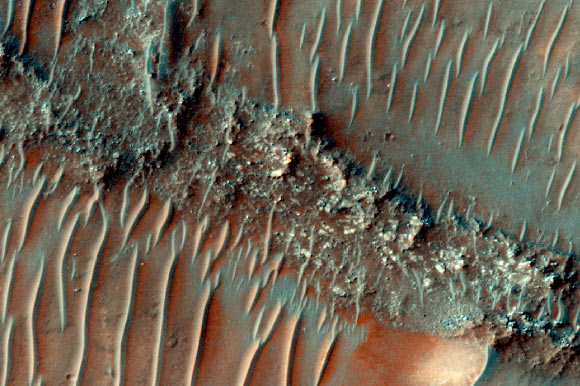Planetary scientists have discovered more than 15,000 km of ancient riverbeds in Noachis Terra, a region in Mars’ southern highlands. This discovery suggests that Mars may once have been much wetter than previously thought.
This HiRISE image shows a flat top, heavily eroded fluvial sinuous ridge on Mars; sand dunes can be seen migrating over the top of the fluvial sinuous ridge. Image credit: NASA / JPL / University of Arizona.
The nature of the Martian climate during the Noachian-Hesperian transition, a period of geologic and climatic changes around 3.7 billion years ago, and how surface features such as valley networks and lakes associated with liquid water formed, is debated.
There are two theories: the first is that warm and wet conditions persisted on early Mars long enough that liquid water was stable on the surface for extended periods; the second is that Mars was generally cold and dry, and that geological features indicative of flowing water were formed only very sporadically by meltwater from ice sheets during short climate excursions.
Noachis Terra is a region where ‘warm, wet’ climate models predict high rates of precipitation.
In new research, Open University Ph.D. student Adam Losekoot and his colleagues looked at fluvial sinuous ridges, also known as inverted channels, across this region.
“These are believed to have formed when sediment deposited by rivers hardened and was later exposed as the surrounding material eroded,” the authors said.
“Similar ridges have been found across a range of terrains on Mars.”
“Their presence suggests that flowing water was once widespread in this region, with precipitation being the most likely source of this water.”
They found fluvial sinuous ridges to be common across Noachis Terra, with a cumulative length of more than 15,000 km.
These are often isolated segments, but some systems are hundreds of km in length.
“Studying Mars, particularly an underexplored region like Noachis Terra, is really exciting because it’s an environment which has been largely unchanged for billions of years,” Losekoot said.
“It’s a time capsule that records fundamental geological processes in a way that just isn’t possible here on Earth.”
For the study, the researchers used data from three orbital instruments: the Context Camera (CTX), the Mars Orbiter Laser Altimeter (MOLA) and the High Resolution Imaging Science Experiment (HiRISE).
These datasets allowed them to map the locations, lengths and morphologies of ridge systems across a wide area.
“Our work is a new piece of evidence that suggests that Mars was once a much more complex and active planet than it is now, which is such an exciting thing to be involved in,” Losekoot said.
“The fact that the ridges form extensive interconnected systems suggests that the watery conditions must have been relatively long-lived, meaning Noachis Terra experienced warm and wet conditions for a geologically relevant period.”
“These findings challenge existing theories that Mars was generally cold and dry, with a few valleys formed by ice-sheet meltwater in sporadic, short periods of warming.”
The scientists presented their results on July 10 at the Royal Astronomical Society’s National Astronomy Meeting 2025 in Durham, the United Kingdom.
_____
Adam Losekoot et al. The Fluvial History of Noachis Terra, Mars. NAM 2025
